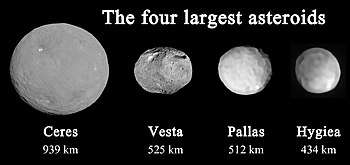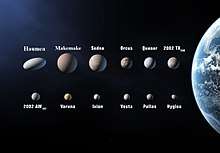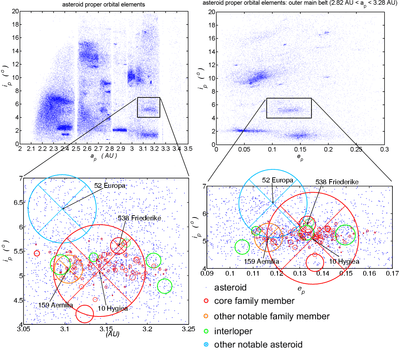10 Hygiea
Hygiea (minor planet designation: 10 Hygiea) is a major asteroid located in the main asteroid belt. With a diameter of 434 kilometres (270 mi) and a mass estimated to be 2.9% of the total mass of the belt,[10] it is the fourth-largest asteroid in the Solar System by both volume and mass. In some spectral classifications it is the largest of the dark C-type asteroids with a carbonaceous surface, in others it is second after 1 Ceres.
 VLT-SPHERE image of Hygiea | |
| Discovery [1] | |
|---|---|
| Discovered by | A. de Gasparis |
| Discovery date | 12 April 1849 |
| Designations | |
| (10) Hygiea | |
| Pronunciation | /haɪˈdʒiːə/[2] |
Named after | Hygieia [3] |
| A900 GA | |
| Main belt (Hygiea family) | |
| Adjectives | Hygiean /haɪˈdʒiːən/[4] |
| Orbital characteristics [1] | |
| Epoch 27 April 2019 (JD 2458600.5) | |
| Uncertainty parameter 0 | |
| Observation arc | 170.23 yr (62,175 days) |
| Aphelion | 3.4948 AU |
| Perihelion | 2.7882 AU |
| 3.1415 AU | |
| Eccentricity | 0.1125 |
| 5.57 yr (2033.8 days) | |
Average orbital speed | 16.76 km/s |
| 152.18° | |
| Inclination | 3.8316° |
| 283.20° | |
| 312.32° | |
| Proper orbital elements [5] | |
Proper semi-major axis | 3.14178 AU |
Proper eccentricity | 0.1356 |
Proper inclination | 5.1039° |
Proper mean motion | 64.6218 deg / yr |
Proper orbital period | 5.57088 yr (2034.762 d) |
Precession of perihelion | 128.544 arcsec / yr |
Precession of the ascending node | −96.9024 arcsec / yr |
| Physical characteristics | |
| Dimensions | 450 km × 430 km × 424 km ± 10 km × 10 km × 20 km |
Mean diameter | 434±14 km[6] |
| Mass | (8.32±0.80)×1019 kg (representative)[7] |
Mean density | 1.94±0.19 g/cm3[7] |
| 13.82559±0.00005 h[6] 27.623 h (1.15 d)[1] (dated) | |
| 0.0717 [1] | |
| Temperature | ≈164 K max: 247 K (−26°C) [8] |
| C-type[1] | |
| 9.0[9] to 11.97 | |
| 5.43[1] | |
| 0.321″ to 0.133″ | |
Observations taken with the Very Large Telescope's SPHERE imager in 2017 and 2018, and announced in late 2019, revealed that Hygiea has a nearly spherical shape, which is at least consistent with it being in hydrostatic equilibrium and thus a dwarf planet.[6][11]
Observation

Despite its size, Hygiea appears very dim when observed from Earth. This is due to its dark surface and its position in the outer main belt. For this reason, six smaller asteroids were observed before Annibale de Gasparis discovered Hygiea on 12 April 1849. At most oppositions, Hygiea has a magnitude that is four magnitudes dimmer than Vesta's, and observing it typically requires at least a 100-millimetre (4 in) telescope. However, while at a perihelic opposition, it can be observed just with 10x50 binoculars as Hygiea would have a magnitude of +9.1.[12]
Discovery and name
On 12 April 1849, in Naples, Italy, astronomer Annibale de Gasparis (age 29) discovered Hygiea.[13] It was the first of his nine asteroid discoveries. The director of the Naples observatory, Ernesto Capocci, named the asteroid. He chose to call it Igea Borbonica ("Bourbon Hygieia") in honor of the ruling family of the Kingdom of the Two Sicilies where Naples was located.[14]
In 1852, John Russell Hind wrote that "it is universally termed Hygiea, the unnecessary appendage 'Borbonica' being dropped"[14] (as well as the final "ia" in favor of just "a"). The name comes from Hygieia, the Greek goddess of health, daughter of Asclepius (Aesculapius for the Romans).[15]
Physical characteristics



Based on spectral evidence, Hygiea's surface is thought to consist of primitive carbonaceous materials similar to those found in carbonaceous chondrite meteorites. Aqueous alteration products have been detected on its surface, which could indicate the presence of water ice in the past which was heated sufficiently to melt.[15] The primitive present surface composition would indicate that Hygiea had not been melted during the early period of Solar System formation,[15] in contrast to other large planetesimals like 4 Vesta.. However, observations in 2019 suggest Hygiea had suffered a head-on collision which had melted it and resulted in its present spherical shape.[6]
In images taken with the Very Large Telescope imager in 2017, a bright surface feature is visible, as well as at least two dark craters, which have been informally[lower-alpha 1] named Serpens and Calix after the Latin words for snake and cup, respectively.[7] Serpens has a size of 180 km, Calix is about 90 km in diameter.[7][6]
Hygiea is the largest of the class of dark C-type asteroids that are dominant in the outer asteroid belt, beyond the Kirkwood gap at 2.82 AU.[17] Hygiea has an average diameter of 434 ± 14 km.[6] While early studies (Ragazzoni et al., 2000) have found a noticeably oblate shape with a semimajor axis ratio of 1.11 (much more than for the other objects in the "big four"—2 Pallas, 4 Vesta and the dwarf planet Ceres),[18][15] recent results indicate that Hygiea is more spherical, with an axis ratio of 1.06,[lower-alpha 2] consistent with a MacLaurin ellipsoid.[6] Aside from being the smallest of the "big four", Hygiea, like Ceres, has a relatively low density, which is more comparable to the icy satellites of Jupiter or Saturn than to the terrestrial planets or the stony asteroids.[19]
Although it is the largest body in its region, due to its dark surface and farther-than-average distance from the Sun, Hygiea appears very dim when observed from Earth. In fact, it is the third dimmest of the first twenty-three asteroids discovered, with only 13 Egeria and 17 Thetis having lower mean opposition magnitudes.[20] At most oppositions, Hygiea has a magnitude of around +10.2,[20] which is as much as four orders fainter than Vesta, and observation calls for at least a 4-inch (100 mm) telescope to resolve.[21] However, at a perihelic opposition, Hygiea can reach +9.1 magnitude and may just be resolvable with 10x50 binoculars, unlike the next two largest asteroids in the asteroid belt, 704 Interamnia and 511 Davida, which are always beyond binocular visibility.[12]
A total of 17 stellar occultations by Hygiea have been tracked by Earth-based astronomers,[22][23] including two (in 2002 and 2014) that were seen by a large number of observers. The observations have been used to constrain Hygiea's size, shape and rotation axis.[24] The Hubble Space Telescope has resolved the asteroid and ruled out the presence of any orbiting companions larger than about 16 kilometres (9.9 mi) in diameter.[25]
Orbit and rotation

Orbiting at an average of 3.14 AU from the Sun, Hygiea is the most distant of the "big four" asteroids. It lies closer to the ecliptic as well, with an orbital inclination of 4°.[15] Its orbit is less circular than those of Ceres or Vesta, with an eccentricity of around 0.12.[1] Its perihelion is at a quite similar longitude to those of Vesta and Ceres, though its ascending and descending nodes are opposite to the corresponding ones for those objects. Although its perihelion is extremely close to the mean distance of Ceres and Pallas, a collision between Hygiea and its larger companions is impossible because at that distance they are always on opposite sides of the ecliptic. In 2056, Hygiea will pass 0.025 AU from Ceres, and then in 2063, Hygiea will pass 0.020 AU from Pallas.[26] At aphelion Hygiea reaches out to the extreme edge of the asteroid belt at the perihelia of the Hilda family, which is in a 3:2 orbital resonance with Jupiter.[27]
As one of the most massive asteroids, Hygiea is used by the Minor Planet Center to calculate perturbations.[28]
Hygiea is in an unstable three-body mean motion resonance with Jupiter and Saturn.[29] The computed Lyapunov time for this asteroid is 30,000 years, indicating that it occupies a chaotic orbit that will change randomly over time because of gravitational perturbations by the planets.[29] It is the lowest numbered asteroid in such a resonance (the next lowest numbered being 70 Panopaea).[29][30]
Hygiea has a rotation period of about 13.8256 hours, determined from observations with the VLT in 2017 and 2018.[6] Its single-peaked light curve has an amplitude of 0.27 mag,[7] which is largely attributed to albedo variations.[6] As of September 2019, the direction of Hygiea's rotation is not known, due to a twofold ambiguity in lightcurve data that is exacerbated by its long rotation period—which makes single-night telescope observations span at best only a fraction of a full rotation—but it is believed to be retrograde.[15] Lightcurve analysis indicates that Hygiea's pole points towards either ecliptic coordinates (β, λ) = (30°, 115°) or (30°, 300°) with a 10° uncertainty.[31] This gives an axial tilt of about 60° in both cases.[31]
Hygiea family

Hygiea is the main member of the Hygiean asteroid family that constitutes about 1% of asteroids in the main belt. The family was formed when an object with a diameter of about 100 km collided with proto-Hygiea about 2 billion years ago. Because the impact craters on Hygiea today are too small to contain the volume of ejected material, it is thought that Hygiea was completely disrupted by the impact and that the majority of the debris recoalesced after the pieces that formed the rest of the family had escaped. Hygiea contains almost all the mass (over 98%) of the family.[6]
See also
References
- "JPL Small-Body Database Browser: 10 Hygiea" (2019-08-18 last obs.). Jet Propulsion Laboratory. Retrieved 28 October 2019.
- "Hygeia". Oxford English Dictionary (3rd ed.). Oxford University Press. September 2005. (Subscription or UK public library membership required.)
- Schmadel, L. D. (2007). "(10) Hygiea". Dictionary of Minor Planet Names – (10) Hygiea. Springer Berlin Heidelberg. p. 16. doi:10.1007/978-3-540-29925-7_11. ISBN 978-3-540-29925-7.
- "hygeian". Oxford English Dictionary (3rd ed.). Oxford University Press. September 2005. (Subscription or UK public library membership required.)
- "AstDyS-2 Hygiea Synthetic Proper Orbital Elements". Department of Mathematics, University of Pisa, Italy. Retrieved 28 April 2019.
- Vernazza, P.; Jorda, L.; Ševeček, P.; Brož, M.; Viikinkoski, M.; Hanuš, J.; et al. (2020). "A basin-free spherical shape as an outcome of a giant impact on asteroid Hygiea" (PDF). Nature Astronomy. 273 (2): 136–141. doi:10.1038/s41550-019-0915-8. hdl:10045/103308. Retrieved 28 October 2019.
- Vernazza, P.; Jorda, L.; Ševeček, P.; Brož, M.; Viikinkoski, M.; Hanuš, J.; et al. (28 October 2019). "A basin-free spherical shape as an outcome of a giant impact on asteroid Hygiea, Supplementary Information" (PDF). Nature Astronomy. doi:10.1038/s41550-019-0915-8. hdl:10045/103308. Retrieved 30 October 2019.
- Lim, L. F.; McConnochie, T.; Belliii, J.; Hayward, T. (2005). "Thermal infrared (8–13 µm) spectra of 29 asteroids: the Cornell Mid-Infrared Asteroid Spectroscopy (MIDAS) Survey". Icarus. 173 (2): 385. Bibcode:2005Icar..173..385L. doi:10.1016/j.icarus.2004.08.005.
- "AstDys (10) Hygiea Ephemerides". Department of Mathematics, University of Pisa, Italy. Retrieved 26 June 2010.
- "Mass of 10 Hygiea" 0.445 / "Mass of Mbelt" Archived 2008-10-31 at the Wayback Machine 15 = 0.0296
- Strickland, A. (28 October 2019). "It's an asteroid! No, it's the new smallest dwarf planet in our solar system". CNN. Retrieved 28 October 2019.
- Ford, D. (29 June 2017). "Asteroid 10 Hygiea at opposition". in-the-sky.org. Retrieved 14 March 2019.
- Leuschner, A. O. (15 July 1922). "Comparison of Theory with Observation for the Minor planets 10 Hygiea and 175 Andromache with Respect to Perturbations by Jupiter". Proceedings of the National Academy of Sciences of the United States of America. 8 (7): 170–173. Bibcode:1922PNAS....8..170L. doi:10.1073/pnas.8.7.170. PMC 1085085. PMID 16586868.
- Hind, J. R. (1852). The Solar System: Descriptive Treatise Upon the Sun, Moon, and Planets, Including an Account of All the Recent Discoveries. G. P. Putnam. p. 126. Bibcode:1852ssdt.book.....H.
- Barucci, M. (2002). "10 Hygiea: ISO Infrared Observations". Icarus. 156 (1): 202. Bibcode:2002Icar..156..202B. doi:10.1006/icar.2001.6775.
- Gingerich, O. (16 August 2006), "The Path to Defining Planets" (PDF), Harvard-Smithsonian Center for Astrophysics and IAU EC Planet Definition Committee chair, p. 4, retrieved 13 March 2007
- "Asteroids: Structure and composition of asteroids". European Space Agency. Retrieved 30 October 2019.
- Ragazzoni, R.; Baruffolo, A.; Marchetti, E.; Ghedina, A.; Farinato, J.; Niero, T.; et al. (2000). "Speckle interferometry measurements of the asteroids 10-Hygiea and 15-Eunomia". Astronomy and Astrophysics. 354: 315–320. Bibcode:2000A&A...354..315R.
- McCord, T. B.; Castillo-Rogez, J.; Rivkin, A. (2011). Russell, C.; Raymond, C. (eds.). "Ceres: Its Origin, Evolution and Structure and Dawn's Potential Contribution". The Dawn Mission to Minor Planets 4 Vesta and 1 Ceres. Springer. 163 (1–4): 63–76. doi:10.1007/s11214-010-9729-9. ISBN 978-1-4614-4902-7.
- Odeh, M. "The Brightest Asteroids". The Jordanian Astronomical Society. Archived from the original on 11 May 2008. Retrieved 21 May 2008.
- "What Can I See Through My Scope?". Ballauer Observatory. 2004. Archived from the original on 22 June 2013. Retrieved 20 July 2008.
- Watanabe, H. (9 September 2018), The Index of Asteroidal Occultation Results, Worldwide ver.2, retrieved 29 October 2019
- Hilton, J. L. "Asteroid Masses and Densities" (PDF). U.S. Naval Observatory. Lunar and Planetar Institute. Archived from the original (PDF) on 19 August 2008. Retrieved 26 August 2008.
- Hanuš, J.; Viikinkoski, M.; Marchis, F.; Ďurech, J.; Kaasalainen, M.; Delbo, M.; Herald, D.; Frappa, E.; Hayamizu, T.; Kerr, S.; Preston, S.; Timerson, B.; Dunham, D.; Talbot, J.; et al. (15 May 2017). "Volumes and bulk densities of forty asteroids from ADAM shape modeling" (PDF). Astronomy & Astrophysics. 601: A114. arXiv:1702.01996. Bibcode:2017A&A...601A.114H. doi:10.1051/0004-6361/201629956. Retrieved 28 July 2019.
- Storrs, A. D.; Wells, E. N.; Zellner, B. H.; Stern, A.; Durda, D. D.; et al. (1999). "Imaging Observations of Asteroids with HST". Bulletin of the American Astronomical Society. 31: 1089. Bibcode:1999DPS....31.1103S.
- "JPL Close-Approach Data: 10 Hygiea". 27 November 2009. Retrieved 2 March 2010.
- L'vov, V. N.; Smekhacheva, R. I.; Smirnov, S. S.; Tsekmejster, S. D. (2007). "Some Peculiarities in the Hildas' Motion" (PDF). Central Astronomical Observatory of Russian Academy of Sciences. 2008. Retrieved 30 October 2019.
- "Perturbing Bodies". Minor Planet Center. Retrieved 18 April 2013.
- Nesvorný, D.; Morbidelli, A. (December 1998). "Three-Body Mean Motion Resonances and the Chaotic Structure of the Asteroid Belt". The Astronomical Journal. 116 (6): 3029–3037. Bibcode:1998AJ....116.3029N. doi:10.1086/300632.
- Family status for each asteroid with synthetic proper elements, AstDyS-2, retrieved 30 October 2019
- M. Kaasalainen (2002). "Models of Twenty Asteroids from Photometric Data" (PDF). Icarus. 159 (2): 369. Bibcode:2002Icar..159..369K. doi:10.1006/icar.2002.6907. Retrieved 23 June 2009.
External links
- 3D model of asteroid Hygiea
- A simulation of the orbit of Hygiea
- Stellar occultation of 11 August 2013 (video)
- "Elements and Ephemeris for (10) Hygiea". Minor Planet Center. Archived from the original on 4 March 2016. Retrieved 26 May 2011. (displays Elong from Sun and V mag for 2011)
- 10 Hygiea at AstDyS-2, Asteroids—Dynamic Site
- 10 Hygiea at the JPL Small-Body Database
